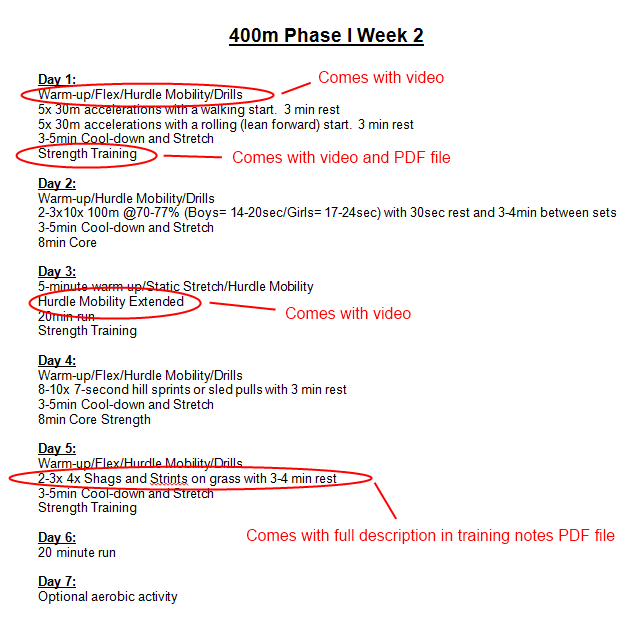Embed Midi File Web Page here. LONDON, ENGLAND – AUGUST 11: Sanya Richards-Ross of the United States approaches he finish line on her way to winning gold in the Women’s 4 x 400m Relay Final on Day 15 of the London 2012 Olympic Games at Olympic Stadium on August 11, 2012 in London, England. (Photo by Stu Forster/Getty Images) The 400m is one of the weird birds of track and field. Probably more so than any other event (other than the 800m) the ‘Many Roads to Rome’ concept seems to hold true. I’d like to take a look at why this is and maybe see what kind of ramifications this can have on a coaches choice of selecting the most appropriate training methods for their athlete’s training.

Aug 19, 2012 I looked at the workout program there. I don't know of any 400m runners putting in 8-14 mile runs but add one lap to the event and all of a. 400 meter Training Workouts. Speed is the focus here. We do a workout. My son is 13 years old and is going to high school.he is running the 400m in pre.
What?When training for the 100m it’s fairly well recognized that regardless of whether you follow a short-to-long or long-to-short periodization plan, that some form of speed training must be present in the training plan to achieve optimal performance. For marathon training, it’s pretty clear cut you’re going to have little to no chance of running an elite marathon by training under 80 100 miles per week. For the 400m though, things aren’t nearly as clear cut.
A Review of 400m Training Methods 24. The tempo-based programs have much larger volumes of running. And if weight lifting and plyometric are performed.
We see programs like Baylor turn out loads of top collegiate 400m runners and 4x400m relay teams with a program is is solidly based on over-distance tempo running. This setup is arguably the most successful training program as it counts Sanya Richards, Andrew Rock, Jeremy Wariner, and Michael Johnson as current or past champions using the setup. In general, the tempo-based programs have much larger volumes of running, most of which is performed at intensities below 85% of maximal sprint speed, and if weight lifting and plyometric are performed at all, they tend to not be highly sophisticated plans and the intensities are again not very high. On the other end of the spectrum, we frequently see short sprinters and even some jumpers and hurdlers step up to the 400m and run world class times with little ‘event-specific’ work. Marion Jones, Asafa Powell, Walter Dix, Allen Johnson have done it in the past and collegiate long and triple jumpers from all around the country do it every weekend on high school and collegiate relays. Athletes in these types of training protocols generally incorporate regular doses of true speed work (95+% with full recovery), and lots of plyometric and /or strength training work.
Somewhere in the middle, we see training plans used by collegiate teams like LSU. LSU has the men’s collegiate 4x400m record, has produced such elite 400m runners as Xavier Carter, Derrick Brew, Alleyne Francique, and Kelly Willie and has had more success with both 400m runners of both genders than any other collegiate program in the country. These programs use a combination of tempo and speed work throughout the year. They also typically integrate well-planned weight training and plyometric schemes to complement the track work. Quite clearly, the 400m is unique in that many training philosophies can be used to produce top level results. Why?The reason we can see such diverse training methods produce such similar results is clearly because of the diverse metabolic demands and necessity for both speed and endurance in the 400m. Despite the 400m being considered a sprint event, recent research indicates that the contribution of the aerobic energy pathway is around 30% of total energy production for elite male 400m runners.
That’s right. ONE THIRD of the energy supplied to run a sub 45 second quarter mile comes from the aerobic energy system. This contribution is likely inversely related to the performance level of the athlete. So slower runners will have an even greater aerobic contribution. What’s also clear is that you’re going to have a hard time being an elite 400m runner without very good speed. Even the top 400m runners who many consider to be endurance based quarter milers with ‘slow’ top-end speed (Butch Reynolds and Jeremy Wariner come to mind) are still extremely fast at shorter sprints (20.46 and 20.19 respectively). So it’s clear that the event requires a unique mix of nearly world class (or better) sprint speed and extreme speed endurance.
Who?I think this is an important question to ask. Obviously a wide range of training protocols have produced equal success in the 400m. Does this means you can just do whatever you want?
Most coaches recognize that not all training plans work for all people. Dokunan Yanar Kitab Pdf. So as a coach, it’s important to either tailor an individual’s training to their specific response-type or only recruit and train athletes that you feel will respond well to the training you feel comfortable using. How?So how is it that such seemingly varied programs can produce such similar results? I think this is partly explained by the above point but there’s certainly more to it than that. Let’s take a look at the extreme ends of the training spectrum. On the tempo-based side, I think that the reason these programs work so well is because: • They develop the 30% aerobic component much more efficiently than programs that focus on anaerobic speed-power development. • While many consider these programs to lack true speed specificity, I think this is only partially true.